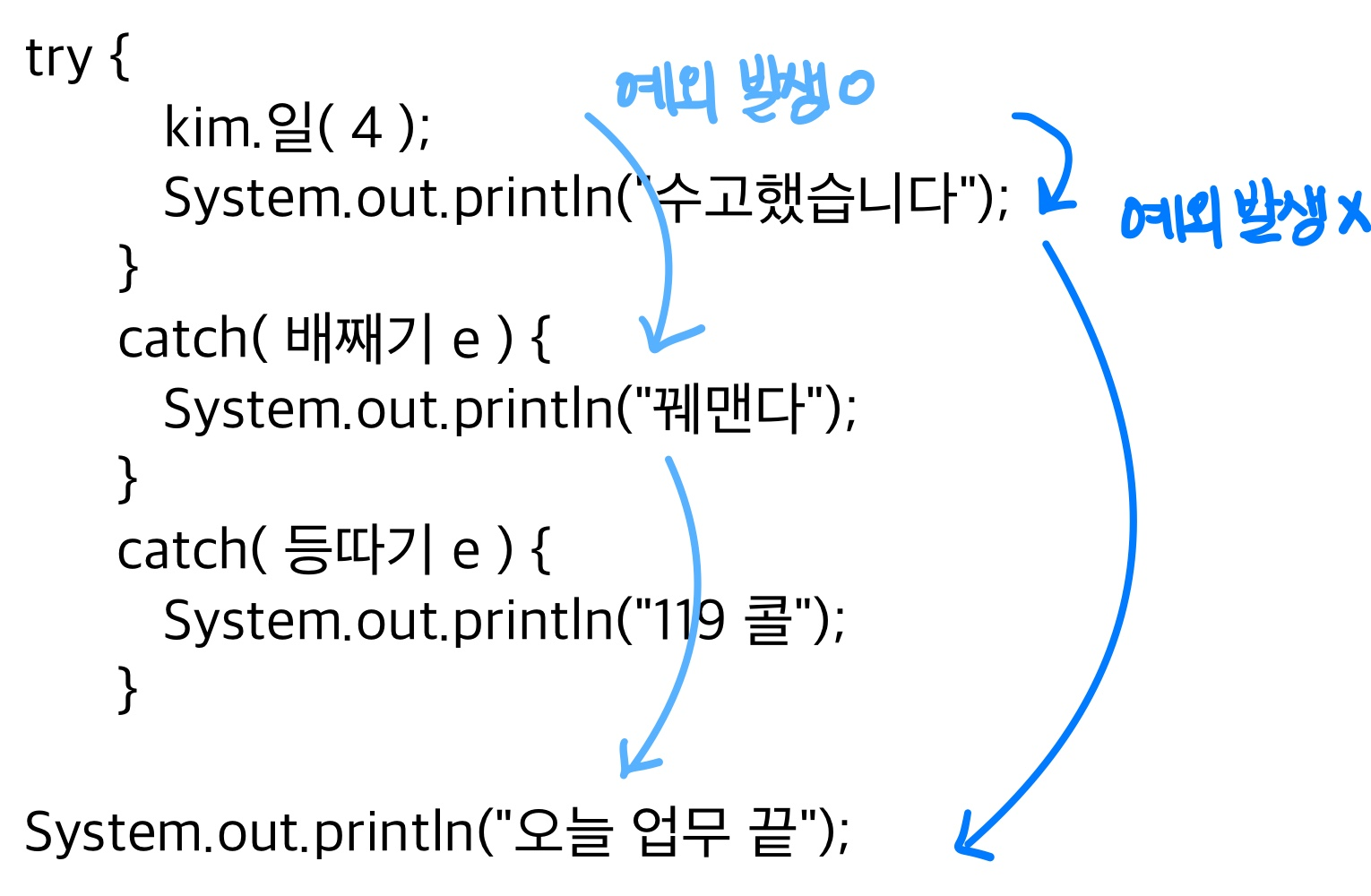예외처리
class 배째기 extends RuntimeException {} class 등따기 extends RuntimeException {} // class 신입 { /* 시간당 7천 이하일때는 30% 확률로 배를 째고 5천 이하일때는 50% 확률로 등을따는 일이 생긴다는 것을 코드로 짜 보면?? */ public void 일( int 시간당 ) { System.out.println("넹넹..."); double rand = Math.random(); if( rand < 0.3 && 시간당 < 7 ) { throw new 배째기(); } else if ( rand < 0.7 && 시간당 < 5 ) { throw new 등따기(); } } } // public class Test174 { public static void main( String[] args ) { 신입 kim = new 신입(); try { kim.일( 4 ); } catch( 배째기 e ) { System.out.println("꿰맨다"); } catch( 등따기 e ) { System.out.println("119 콜"); } } }
예외처리 : 프로그램 동작시의 오류를 처리하는 방법
- 함수가
호출될때 오동작은 발생한다. - 각종 예외상황은 클래스로 정의된다. ( extends RuntimeException )
- 예외상황이 발생되면 해당 예외상황에 해당하는 클래스의
인스턴스를 만들고 그것을 던진다. ( throw new 인스턴스(); ) - 던져진 예외는
catch되지 않으면 프로그램은 종료된다.
( 오동작이 발생하면 그에 대한 처리를 하지 않으면 프로그램은 종료 ) - 적절히 처리된 오동작은 마치 없었다는 듯이 프로그램은 수행을 계속한다.
try~catch
오동작 가능성이 있는 함수호출하는 영역을 try { ... } 로 감싸주고 ... 안에서 배째기가 벌어졌을때 처리하는 코드는 catch( 배째기 e ) { ... } 에 둔다.
등따기가 벌어졌을때 처리하는 코드는 catch( 등따기 e ) { ... } 에 둔다.
class 배째기 extends RuntimeException {} class 등따기 extends RuntimeException {} // class 신입 { public void 일( int 시간당 ) { System.out.println("넹넹..."); double rand = Math.random(); if( rand < 0.3 && 시간당 < 7 ) { throw new 배째기(); } else if ( rand < 0.7 && 시간당 < 5 ) { throw new 등따기(); } System.out.println("끝났습니다"); } } // public class Test175 { public static void main( String[] args ) { 신입 kim = new 신입(); kim.일( 4 ); System.out.println("수고했습니다"); } }
try ~ catch 없어도 컴파일은 된다. 물론 실행하다 에러나면 프로그램은 죽지만 예외가 발생하면 그 이하의 코드는 수행하지 않는다 - 거기서 프로그램은 끝난다.
Exception
class 배째기 extends Exception {} class 등따기 extends Exception {} // class 신입 { // 해당예외를 발생시킬 수 있음을 선언부에 명시한 코드 public void 일( int 시간당 ) throws 배째기, 등따기 { } } // public class Test176 { public static void main( String[] args ) { 신입 kim = new 신입(); try { kim.일( 4 ); System.out.println("수고했습니다"); } catch( 배째기 e ) { System.out.println("꿰맨다"); } catch( 등따기 e ) { System.out.println("119"); } System.out.println("오늘업무 끝"); } }
RuntimeException : 문법적으로 널널하다 ,
Exception 문법적으로 엄격하다
Exception 을 상속받은 예외를 발생할 수 있는 함수는 선언부에 반드시 그 사실을 명시해야 한다. ( RuntimeException 은 해도 되고 안해도 되고 ) : throws 배째기, 등따기

선언부에 예외발생 가능성이 명시된 함수는 호출시에 반드시 해당 에러를 처리할 수 있는 try ~ catch 영역 안에서 호출해야 한다.
try { kim.일( 4 ); System.out.println("수고했습니다"); } catch( Exception e ) { System.out.println("통합대책 " + e.getClass().getName() ); }
배째기와 등따기 모두에 대해서 동작한다.
Exception e = new 배째기() or new 등따기(); 이 가능하면 잡는다.
즉 "catch 에 선언된 매개변수(?)가 throw 한 예외 인스턴스를 가리킬 수 있을때 잡는다."
Throwable
catch( Throwable e ) { System.out.println("통합대책 " + e.getClass().getName() ); } ``
Throwable 은 Exception 의 부모클래스이다.
예외상황이 아닌 경우에도 try catch 를 이용한 코드를 만들어야 할 때가 있어서 모든 try catch 를 쓰는 경우는 Throwable 로 상속받고 , 그중의 예외상황은 Exception 을 상속받고 ,
RuntimeException 은 Exception 을 상속받는다 ( 널널한 예외 )
- Throwable ( 왕조상 ) - Exception ( 조상 ) - RuntimeException
finally
try { } catch( Exception e ) { } finally { }
try 에서 예외가 발생하건 발생하지 않건 무조건 실행하는 영역
import static
package banana; import static banana.Temp.print; // class Temp { public static void print() { System.out.println("print"); } } // public class Test184 { public static void main( String[] args ) { print(); } }
static import 는 대상이 class 가 아니라 class 안에 선언된 static 함수이고 마치 c 에서 함수호출 하듯이 static 한 함수를 함수명만으로 호출 할 수 있다.
OutputStream
public class Test185 { public static void main( String[] args ) { OutputStream out = null; try { out = new FileOutputStream("C:\\JavaWork\\a.dat"); out.close(); } // catch( FileNotFoundException e ) { } catch( IOException e ) { } }
FileNotFoundException extends IOException 이기에
catch( IOException e ) {} 하나만 배치해도 문제 없다.
public class Test187 { public static void main( String[] args ) { try { OutputStream out = new FileOutputStream("C:\\JavaWork\\a.dat"); out.write( 100 ); out.write( 101 ); out.write( 123456 ); out.close(); } catch( IOException e ) { System.out.println( e ); } } }
FileOutputStream : 해당 파일에 정보를 기록하게 해 주는 클래스
write : 한번 호출할때 한바이트씩 기록 ( int 는 32비트인데? - 32비트 중 하위 8비트만 기록 )
close : 다 끝나면 호출해준다.
InputStream
public class Test188 { public static void main( String[] args ) { try { InputStream in = new FileInputStream("C:\\JavaWork\\a.dat"); int a = in.read(); int b = in.read(); int c = in.read(); int d = in.read(); in.close(); // System.out.println( a ); // 100 System.out.println( b ); // 101 System.out.println( c ); // 64 (256 넘는 값은 저장하면서 잘림) System.out.println( d ); // 읽을게 없어서 -1 } catch( IOException e ) { System.out.println( e ); } } }
OutputStream 에 void write( int ) 가 있으면
InputStream 에는 int read() 가 있다.
순서대로 write 된 내용을 순서대로 read 하는 형태로 동작하고 있다. 순서대로 읽다가 더 이상 읽을 것이 없을때는 -1 이 리턴된다. ( Test187 코드와 연동해서 이해)
public class Test189 { public static void main( String[] args ) { try { InputStream in = new FileInputStream("C:\\JavaWork\\a.dat"); // 이 코드는 반드시 암기할 것!!! int r = 0; while( ( r = in.read() ) != -1 ) { System.out.println( r ); } in.close(); } catch( IOException e ) { System.out.println( e ); } } }
in.read() 한 값이 -1 이 아닐때까지 while 문이 동작한다.
이해를 돕기위한 코드
boolean alive = true;
while( alive ) {
int r = in.read();
if( r == -1 ) {
alive = false;
} else {
System.out.println( r );
}
}